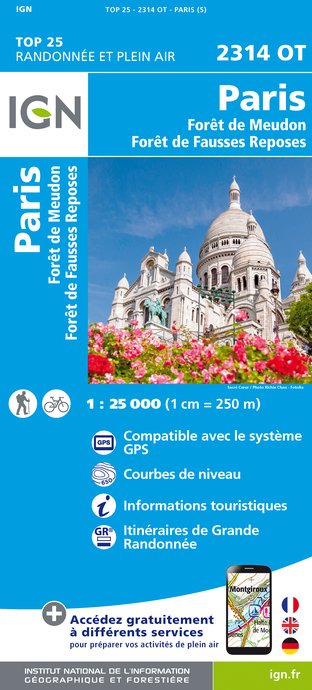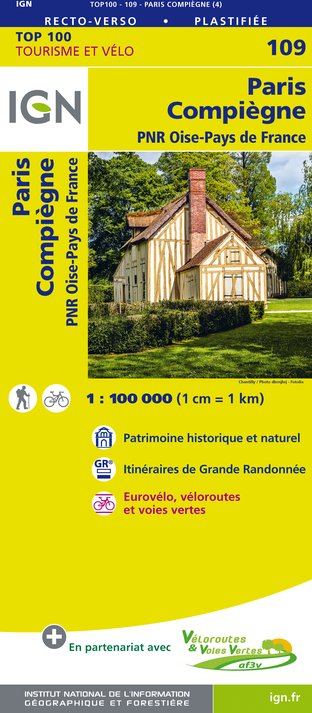Warnung
Warnungen
Art der Übung
Wandern
Sehr einfach
2h
Fahrrad
Sehr einfach
1h
Präsentation
Karte
Sehenswürdigkeiten
Cirkwi Kurzbeschreibung
Bewertungen und Rezensionen
In der Umgebung sehen
Frische und Rückkehr zu den Quellen: die Brunnen von Paris

Kredit : Moonik via Wikipedia
Die Cirkwi Kurzbeschreibung
Entdecke Paris: Eine Reise durch seine ikonischen Brunnen
Vorgeschlagen von Balades-Fluviales-An-Eala, geht es bei dieser Reise weniger um das Erreichen eines Ziels, sondern vielmehr um die Reise selbst - einen Spaziergang durch die Geschichte, geführt von den faszinierenden Wassern von Paris. Stell dir vor, wie du durch die Straßen von Paris schlenderst, bei jedem Schritt Geschichten vergangener Epochen entdeckst und vom sanften Rauschen des fließenden Wassers begleitet wirst. Das Ziel ist es nicht nur, den ästhetischen und historischen Charme jedes Brunnens zu präsentieren, sondern dich in die von ihnen geschaffene Atmosphäre einzutauchen - eine Oase der Ruhe und Schönheit mitten im Trubel der Stadt. Lass diese Wasser ihre Geschichten flüstern, von monumental bis verborgen, und bereichere deinen Spaziergang mit Schichten der Pariser Geschichte und Kultur.
Technische Routenkenntnisse erklärt
Diese Route, die eine Strecke von 6,8 km umfasst, ist als moderater Spaziergang konzipiert und für Enthusiasten aller Fitnessniveaus geeignet. Mit einem Startpunkt in 27 Metern Höhe und einem Höhepunkt von 41 Metern verspricht die Strecke einen minimalen Höhenunterschied von nur 23 Metern in beide Richtungen, was einen gemütlichen Rhythmus gewährleistet. Mit diesen Spezifikationen können Reisende die malerische Aussicht und historische Einblicke ohne körperliche Anstrengung genießen. Diese technische Leichtigkeit erhöht die Zugänglichkeit der Tour und lädt eine vielfältige Gruppe von Besuchern zur Teilnahme ein.
Saisonale Tipps für Brunnenliebhaber
Eine Brunnen-Tour durch Paris kann das ganze Jahr über eine Freude sein, aber jede Jahreszeit bietet einzigartige Erfahrungen. Im Frühling kannst du die blühende Flora bewundern, die eine lebhafte Kulisse für die historischen Gewässer bietet. Im Sommer, obwohl wärmer, erwachen die Brunnen als erfrischende Oasen zum Leben - vergiss jedoch nicht Sonnenschutz und Wasser! Der Herbst taucht alles in ein goldenes Licht, perfekt für Fotografie-Enthusiasten, während der Winter trotz der Kälte eine ruhigere Reise mit weniger Menschenmassen bietet. Unabhängig von der Jahreszeit wird bequemes Schuhwerk empfohlen, und sei immer auf plötzliche Wetteränderungen in Paris vorbereitet.
Paris: Ein enthülltes historisches Gewebe
Paris, das in der Region Île-de-France liegt, ist nicht nur die Hauptstadt des Landes, sondern auch sein historisches und kulturelles Herz. Die Vielzahl der Brunnen in der Stadt spiegelt die geschichtliche Entwicklung wider, jede erzählt von gesellschaftlichen Veränderungen, architektonischen Bewegungen und städtebaulicher Entwicklung. Von den Zeiten der Renovierungen durch Haussmann, die Paris radikal veränderten, um öffentliche Gesundheitskrisen zu bekämpfen, bis zur heutigen Erhaltung dieser Wasserjuwelen spiegelt sich die Reise dieser Brunnen in der dynamischen Entwicklung von Paris selbst wider. Sie stehen als stille Erzähler der Vergangenheit und sind Zeugen des unablässigen Voranschreitens der Stadt durch die Zeit.
Klimaführer für Besucher von Paris
Paris, das ein gemäßigtes ozeanisches Klima hat, genießt das ganze Jahr über milde Temperaturen. Frühling und Herbst sind besonders angenehm und eignen sich daher ideal, um die historischen Brunnen im Freien zu erkunden. Die Winter sind relativ mild, können jedoch kältere Perioden mitbringen, während die Sommer zwar wärmer, aber im Allgemeinen angenehm temperiert sind - ein Segen für diejenigen, die Erholung in den kühlen Wassern suchen. Um das Erlebnis maximal zu genießen, empfiehlt es sich, von April bis Juni oder von September bis November zu besuchen, wenn das Wetter am besten zum Wandern und Entdecken des Pariser Freiluft-Erbes geeignet ist.
Vorgeschlagen von Balades-Fluviales-An-Eala, geht es bei dieser Reise weniger um das Erreichen eines Ziels, sondern vielmehr um die Reise selbst - einen Spaziergang durch die Geschichte, geführt von den faszinierenden Wassern von Paris. Stell dir vor, wie du durch die Straßen von Paris schlenderst, bei jedem Schritt Geschichten vergangener Epochen entdeckst und vom sanften Rauschen des fließenden Wassers begleitet wirst. Das Ziel ist es nicht nur, den ästhetischen und historischen Charme jedes Brunnens zu präsentieren, sondern dich in die von ihnen geschaffene Atmosphäre einzutauchen - eine Oase der Ruhe und Schönheit mitten im Trubel der Stadt. Lass diese Wasser ihre Geschichten flüstern, von monumental bis verborgen, und bereichere deinen Spaziergang mit Schichten der Pariser Geschichte und Kultur.
Technische Routenkenntnisse erklärt
Diese Route, die eine Strecke von 6,8 km umfasst, ist als moderater Spaziergang konzipiert und für Enthusiasten aller Fitnessniveaus geeignet. Mit einem Startpunkt in 27 Metern Höhe und einem Höhepunkt von 41 Metern verspricht die Strecke einen minimalen Höhenunterschied von nur 23 Metern in beide Richtungen, was einen gemütlichen Rhythmus gewährleistet. Mit diesen Spezifikationen können Reisende die malerische Aussicht und historische Einblicke ohne körperliche Anstrengung genießen. Diese technische Leichtigkeit erhöht die Zugänglichkeit der Tour und lädt eine vielfältige Gruppe von Besuchern zur Teilnahme ein.
Saisonale Tipps für Brunnenliebhaber
Eine Brunnen-Tour durch Paris kann das ganze Jahr über eine Freude sein, aber jede Jahreszeit bietet einzigartige Erfahrungen. Im Frühling kannst du die blühende Flora bewundern, die eine lebhafte Kulisse für die historischen Gewässer bietet. Im Sommer, obwohl wärmer, erwachen die Brunnen als erfrischende Oasen zum Leben - vergiss jedoch nicht Sonnenschutz und Wasser! Der Herbst taucht alles in ein goldenes Licht, perfekt für Fotografie-Enthusiasten, während der Winter trotz der Kälte eine ruhigere Reise mit weniger Menschenmassen bietet. Unabhängig von der Jahreszeit wird bequemes Schuhwerk empfohlen, und sei immer auf plötzliche Wetteränderungen in Paris vorbereitet.
Paris: Ein enthülltes historisches Gewebe
Paris, das in der Region Île-de-France liegt, ist nicht nur die Hauptstadt des Landes, sondern auch sein historisches und kulturelles Herz. Die Vielzahl der Brunnen in der Stadt spiegelt die geschichtliche Entwicklung wider, jede erzählt von gesellschaftlichen Veränderungen, architektonischen Bewegungen und städtebaulicher Entwicklung. Von den Zeiten der Renovierungen durch Haussmann, die Paris radikal veränderten, um öffentliche Gesundheitskrisen zu bekämpfen, bis zur heutigen Erhaltung dieser Wasserjuwelen spiegelt sich die Reise dieser Brunnen in der dynamischen Entwicklung von Paris selbst wider. Sie stehen als stille Erzähler der Vergangenheit und sind Zeugen des unablässigen Voranschreitens der Stadt durch die Zeit.
Klimaführer für Besucher von Paris
Paris, das ein gemäßigtes ozeanisches Klima hat, genießt das ganze Jahr über milde Temperaturen. Frühling und Herbst sind besonders angenehm und eignen sich daher ideal, um die historischen Brunnen im Freien zu erkunden. Die Winter sind relativ mild, können jedoch kältere Perioden mitbringen, während die Sommer zwar wärmer, aber im Allgemeinen angenehm temperiert sind - ein Segen für diejenigen, die Erholung in den kühlen Wassern suchen. Um das Erlebnis maximal zu genießen, empfiehlt es sich, von April bis Juni oder von September bis November zu besuchen, wenn das Wetter am besten zum Wandern und Entdecken des Pariser Freiluft-Erbes geeignet ist.
Automatisch generiert.
IGN Karten

2314OT - PARIS FORÊT DE MEUDON FORÊT DE FAUSSES REPOSES
Herausgeber : IGN
Sammlung : TOP 25 ET SÉRIE BLEUE
Leiter : 1:25 000
13.90€

119 PARIS SENS PNR DU GÂTINAIS FRANÇAIS
Herausgeber : IGN
Sammlung : TOP 100
Leiter : 1:100 000
8.40€

190 PARIS CHANTILLY FONTAINEBLEAU
Herausgeber : IGN
Sammlung : TOP 100
Leiter : 1:100 000
8.40€

118 PARIS CHARTRES PNR DE LA HAUTE VALLÉE DE CHEVREUSE
Herausgeber : IGN
Sammlung : TOP 100
Leiter : 1:100 000
8.40€

109 PARIS COMPIÈGNE PNR OISE-PAYS DE FRANCE
Herausgeber : IGN
Sammlung : TOP 100
Leiter : 1:100 000
8.40€

108 PARIS ROUEN BEAUVAIS PNR DU VEXIN FRANÇAIS
Herausgeber : IGN
Sammlung : TOP 100
Leiter : 1:100 000
8.40€

D75-95 ÎLE-DE-FRANCE OUEST
Herausgeber : IGN
Sammlung : CARTES DÉPARTEMENTALES IGN
Leiter : 1:150 000
5.90€

D77 SEINE-ET-MARNE
Herausgeber : IGN
Sammlung : CARTES DÉPARTEMENTALES IGN
Leiter : 1:150 000
5.90€

NR08 CENTRE-VAL DE LOIRE
Herausgeber : IGN
Sammlung : CARTES RÉGIONALES IGN
Leiter : 1:250 000
6.80€

NR03 ÍLE DE FRANCE
Herausgeber : IGN
Sammlung : CARTES RÉGIONALES IGN
Leiter : 1:250 000
6.80€

NR01 HAUTS-DE-FRANCE
Herausgeber : IGN
Sammlung : CARTES RÉGIONALES IGN
Leiter : 1:250 000
6.80€

801 FRANCE NORD OUEST
Herausgeber : IGN
Sammlung : CARTES NATIONALES IGN
Leiter : 1:320 000
6.10€

EUROPE
Herausgeber : IGN
Sammlung : DÉCOUVERTE DES PAYS DU MONDE IGN
Leiter : 1:2 500 000
7.00€
Technische Informationen
Wandern
Schwierigkeit
Sehr einfach
Dauer
2h
(1T)
Entfernung
6.8 km
Art der Übung
Wandern
Sehr einfach
2h
Fahrrad
Sehr einfach
1h
Mehr anzeigen
Höhenprofil
Ausgangspunkt
75006
Paris
Lat : 48.8534421Lng : 2.3437786
Sehenswürdigkeiten
Datenautor

vorgeschlagen von
Balades-Fluviales-An-Eala
Bewertungen und Rezensionen
In der Umgebung sehen







